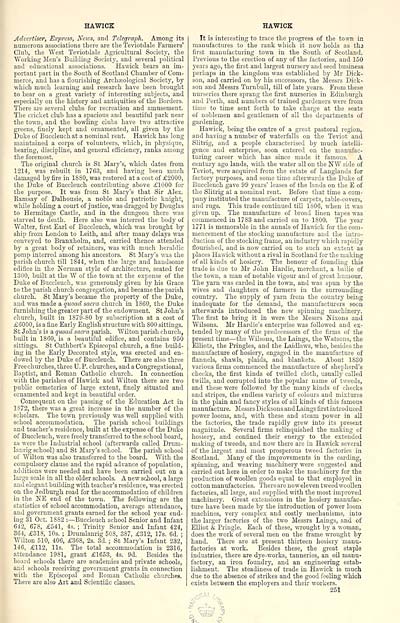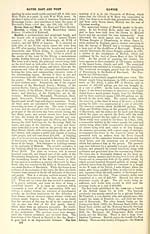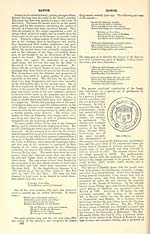Ordnance gazetteer of Scotland > Volume 4
(31) Page 251
Download files
Complete book:
Individual page:
Thumbnail gallery: Grid view | List view

HAWICK
Advertiser, Express, News, and Telegraph. Among its
numerous associations there are the Teviotdale Farmers'
Club, the "West Teviotdale Agricultural Society, the
Working Men's Building Society, and several political
and educational associations. Hawick hears an im-
portant part in the South of Scotland Chamber of Com-
merce, and has a flourishing Archaeological Society, by
which much learning and research have been brought
to bear on a great variety of interesting subjects, and
especially on the history and antiquities of the Borders.
There are several clubs for recreation and amusement.
The cricket club has a spacious and beautiful park near
the town, and the bowling clubs have two attractive
greens, finely kept and ornamented, all given by the
Duke of Buccleuch at a nominal rent. Hawick has long
maintained a corps of volunteers, which, in physique,
bearing, discipline, and general efficiency, ranks among
the foremost.
The original church is St Mary's, which dates from
1214, was rebuilt in 1763, and having been much
damaged by fire in 1SS0, was restored at a cost of £2000,
the Duke of Buccleuch contributing above £1000 for
the purpose. It was from St Mary's that Sir Alex.
Eamsay of Dalhousie, a noble and patriotic knight,
while holding a court of justice, was dragged by Douglas
to Hermitage Castle, and in the dungeon there was
starved to death. Here also was interred the body of
Walter, first Earl of Buccleuch, which was brought by
ship from London to Leith, and after many delays was
conveyed to Branxholm, and, carried thence attended
by a great body of retainers, was with much heraldic
pomp interred among his ancestors. St Mary's was the
parish church till 1844, when the large and handsome
edifice in the Norman style of architecture, seated for
1300, built at the W of the town at the expense of the
Duke of Buccleuch, was generously given by his Grace
to the parish church congregation, and became the parish
church. St Mary's became the property of the Duke,
and was made a quoad sacra church in 1S60, the Duke
furnishing the greater part of the endowment. St John's
church, built in 1879-SO by subscription at a cost of
£6000, is a fine Early English structure with 800 sittings.
St John's is a quoad saera parish. Wilton parish church,
built in 1860, is a beautiful edifice, and contains 950
sittings. St Cuthbert's Episcopal church, a fine build-
ing in the Early Decorated style, was erected and en-
dowed by the Duke of Buccleuch. There are also three
Free churches, three IT. P. churches, and a Congregational,
Baptist, and Roman Catholic church. In connection
with the parishes of Hawick and Wilton there are two
public cemeteries of large extent, finely situated and
ornamented and kept in beautiful order.
Consequent on the passing of the Education Act in
1S72, there was a great increase in the number of the
scholars. The town previously was well supplied with
school accommodation. The parish school buildings
and teacher's residence, built at the expense of the Duke
of Buccleuch, were freely transferred to the school board,
as were the Industrial school (afterwards called Drum-
Ian rig school) and St Mary's school. The parish school
of Wilton was also transferred to the board. With the
compulsory clause and the rapid advance of population,
additions were needed and have been carried out on a
large scale in all the older schools. A new school, a large
and elegant building with teacher's residence, was erected
on the Jedburgh road for the accommodation of children
in the NE end of the town. The following are the
statistics of school accommodation, average attendance,
and government grants earned for the school year end-
ing 31 Oct. 1882 : — Buccleuch school Senior and Infant
642, 678, £541, 4s. ; Trinity Senior and Infant 424,
364, £318, 10s. ; Drumlanrig 50S, 3S7, £312, 17s. 6d. ;
Wilton 510, 406, £368, 2s. 3d. ; St Mary's Infant 232,
146, £112, lis. The total accommodation is 2316,
attendance 1981, grant £1653, 4s. 9d. Besides the
board schools there are academies and private schools,
and schools receiving government grants in connection
with the Episcopal and Bonian Catholic churches.
There are also Art and Scientific classes.
HAWICK
It is interesting to trace the progress of the town in
manufactures to the rank which it now holds as tha
first manufacturing town in the South of Scotland.
Previous to the erection of any of the factories, and 150
years ago, the first and largest nursery and seed business
perhaps in the kingdom was established by Mr Dick-
son, and carried on by his successors, the Messrs Dick-
son and Messrs Turnbull, till of late years. From these
nurseries there sprang the first nurseries in Edinburgh
and Perth, and numbers of trained gardeners were from
time to time sent forth to take charge at the seats
of noblemen and gentlemen of all the departments of
gardening.
Hawick, being the centre of a great pastoral region,
and having a number of waterfalls on the Teviot and
Slitrig, and a people characterised by much intelli-
gence and enterprise, soon entered on the manufac-
turing career which has since made it famous. A
century ago lands, with the water all on the NW side of
Teviot, were acquired from the estate of Langlands for
factory purposes, and some time afterwards the Duke of
Buccleuch gave 99 years' leases of the lands on the E of
the Slitrig at a nominal rent. Before that time a com-
pany instituted the manufacture of carpets, table-covers,
and rugs. This trade continued till 1806, when it was
given up. The manufacture of broad linen tapes was
commenced in 1783 and carried on to 1800. The year
1771 is memorable in the annals of Hawick for the com-
mencement of the stocking manufacture and the intro-
duction of the stocking frame, an industry which rapidly
flourished, and is now carried on to such an extent as
places Hawick without a rival in Scotland for the making
of all kinds of hosiery. The honour of founding this
trade is due to Mr John Hardie, merchant, a bailie of
the town, a man of notable vigour and of great humour.
The yarn was carded in the town, and was spun by the
wives and daughters of farmers in the surrounding
country. The supply of yarn from the country being
inadequate for the demand, the manufacturers soon
afterwards introduced the new spinning machinery.
The first to bring it in were the Messrs Nixons and
Wilsons. Mr Hardie's enterprise was followed and ex-
tended by many of the predecessors of the firms of the
present time — the Wilsons, the Laings, the Watsons, the
Elliots, the Pringles, and the Laidlaws, who, besides the
manufacture of hosiery, engaged in the manufacture of
flannels, shawls, plaids, and blankets. About 1830
various firms commenced the manufacture of shepherd's
checks, the first kinds of twilled cloth, usually called
twills, and corrupted into the popular name of tweeds,
and these were followed by the many kinds' of checks
and stripes, the endless variety of colours and mixtures
in the plain and fancy styles of all kinds of this famous
manufacture. Messrs Dicksons and Laings first introduced
power looms, and, with these and steam pow : er in all
the factories, the trade rapidly grew into its present
magnitude. Several firms relinquished the making of
hosiery, and confined their energy to the extended
making of tweeds, and now there are in Hawick several
of the largest and most prosperous tweed factories in
Scotland. Many of the improvements in the carding,
spinning, and weaving machinery were suggested and
carried out here in order to make the machinery for the
production of woollen goods equal to that employed in
cotton manufactories. There are no w eleven tweed woollen
factories, all large, and supplied with the most improved
machinery. Great extensions in the hosiery manufac-
ture have been made by the introduction of power loom
machines, very complex and costly mechanisms, into
the larger factories of the two Messrs Laings, and of
Elliot & Priugle. Each of these, wrought by a woman,
does the work of several men on the frame wrought by
hand. There are at present thirteen hosiery manu-
factories at work. Besides these, the great staple
industries, there are dye-works, tanneries, an oil manu-
factory, an iron foundry, and an engineering estab-
lishment. The steadiness of trade in Hawick is much
due to the absence of strikes and the good feeling which
exists between the employers and their workers.
251
'■'
-
Advertiser, Express, News, and Telegraph. Among its
numerous associations there are the Teviotdale Farmers'
Club, the "West Teviotdale Agricultural Society, the
Working Men's Building Society, and several political
and educational associations. Hawick hears an im-
portant part in the South of Scotland Chamber of Com-
merce, and has a flourishing Archaeological Society, by
which much learning and research have been brought
to bear on a great variety of interesting subjects, and
especially on the history and antiquities of the Borders.
There are several clubs for recreation and amusement.
The cricket club has a spacious and beautiful park near
the town, and the bowling clubs have two attractive
greens, finely kept and ornamented, all given by the
Duke of Buccleuch at a nominal rent. Hawick has long
maintained a corps of volunteers, which, in physique,
bearing, discipline, and general efficiency, ranks among
the foremost.
The original church is St Mary's, which dates from
1214, was rebuilt in 1763, and having been much
damaged by fire in 1SS0, was restored at a cost of £2000,
the Duke of Buccleuch contributing above £1000 for
the purpose. It was from St Mary's that Sir Alex.
Eamsay of Dalhousie, a noble and patriotic knight,
while holding a court of justice, was dragged by Douglas
to Hermitage Castle, and in the dungeon there was
starved to death. Here also was interred the body of
Walter, first Earl of Buccleuch, which was brought by
ship from London to Leith, and after many delays was
conveyed to Branxholm, and, carried thence attended
by a great body of retainers, was with much heraldic
pomp interred among his ancestors. St Mary's was the
parish church till 1844, when the large and handsome
edifice in the Norman style of architecture, seated for
1300, built at the W of the town at the expense of the
Duke of Buccleuch, was generously given by his Grace
to the parish church congregation, and became the parish
church. St Mary's became the property of the Duke,
and was made a quoad sacra church in 1S60, the Duke
furnishing the greater part of the endowment. St John's
church, built in 1879-SO by subscription at a cost of
£6000, is a fine Early English structure with 800 sittings.
St John's is a quoad saera parish. Wilton parish church,
built in 1860, is a beautiful edifice, and contains 950
sittings. St Cuthbert's Episcopal church, a fine build-
ing in the Early Decorated style, was erected and en-
dowed by the Duke of Buccleuch. There are also three
Free churches, three IT. P. churches, and a Congregational,
Baptist, and Roman Catholic church. In connection
with the parishes of Hawick and Wilton there are two
public cemeteries of large extent, finely situated and
ornamented and kept in beautiful order.
Consequent on the passing of the Education Act in
1S72, there was a great increase in the number of the
scholars. The town previously was well supplied with
school accommodation. The parish school buildings
and teacher's residence, built at the expense of the Duke
of Buccleuch, were freely transferred to the school board,
as were the Industrial school (afterwards called Drum-
Ian rig school) and St Mary's school. The parish school
of Wilton was also transferred to the board. With the
compulsory clause and the rapid advance of population,
additions were needed and have been carried out on a
large scale in all the older schools. A new school, a large
and elegant building with teacher's residence, was erected
on the Jedburgh road for the accommodation of children
in the NE end of the town. The following are the
statistics of school accommodation, average attendance,
and government grants earned for the school year end-
ing 31 Oct. 1882 : — Buccleuch school Senior and Infant
642, 678, £541, 4s. ; Trinity Senior and Infant 424,
364, £318, 10s. ; Drumlanrig 50S, 3S7, £312, 17s. 6d. ;
Wilton 510, 406, £368, 2s. 3d. ; St Mary's Infant 232,
146, £112, lis. The total accommodation is 2316,
attendance 1981, grant £1653, 4s. 9d. Besides the
board schools there are academies and private schools,
and schools receiving government grants in connection
with the Episcopal and Bonian Catholic churches.
There are also Art and Scientific classes.
HAWICK
It is interesting to trace the progress of the town in
manufactures to the rank which it now holds as tha
first manufacturing town in the South of Scotland.
Previous to the erection of any of the factories, and 150
years ago, the first and largest nursery and seed business
perhaps in the kingdom was established by Mr Dick-
son, and carried on by his successors, the Messrs Dick-
son and Messrs Turnbull, till of late years. From these
nurseries there sprang the first nurseries in Edinburgh
and Perth, and numbers of trained gardeners were from
time to time sent forth to take charge at the seats
of noblemen and gentlemen of all the departments of
gardening.
Hawick, being the centre of a great pastoral region,
and having a number of waterfalls on the Teviot and
Slitrig, and a people characterised by much intelli-
gence and enterprise, soon entered on the manufac-
turing career which has since made it famous. A
century ago lands, with the water all on the NW side of
Teviot, were acquired from the estate of Langlands for
factory purposes, and some time afterwards the Duke of
Buccleuch gave 99 years' leases of the lands on the E of
the Slitrig at a nominal rent. Before that time a com-
pany instituted the manufacture of carpets, table-covers,
and rugs. This trade continued till 1806, when it was
given up. The manufacture of broad linen tapes was
commenced in 1783 and carried on to 1800. The year
1771 is memorable in the annals of Hawick for the com-
mencement of the stocking manufacture and the intro-
duction of the stocking frame, an industry which rapidly
flourished, and is now carried on to such an extent as
places Hawick without a rival in Scotland for the making
of all kinds of hosiery. The honour of founding this
trade is due to Mr John Hardie, merchant, a bailie of
the town, a man of notable vigour and of great humour.
The yarn was carded in the town, and was spun by the
wives and daughters of farmers in the surrounding
country. The supply of yarn from the country being
inadequate for the demand, the manufacturers soon
afterwards introduced the new spinning machinery.
The first to bring it in were the Messrs Nixons and
Wilsons. Mr Hardie's enterprise was followed and ex-
tended by many of the predecessors of the firms of the
present time — the Wilsons, the Laings, the Watsons, the
Elliots, the Pringles, and the Laidlaws, who, besides the
manufacture of hosiery, engaged in the manufacture of
flannels, shawls, plaids, and blankets. About 1830
various firms commenced the manufacture of shepherd's
checks, the first kinds of twilled cloth, usually called
twills, and corrupted into the popular name of tweeds,
and these were followed by the many kinds' of checks
and stripes, the endless variety of colours and mixtures
in the plain and fancy styles of all kinds of this famous
manufacture. Messrs Dicksons and Laings first introduced
power looms, and, with these and steam pow : er in all
the factories, the trade rapidly grew into its present
magnitude. Several firms relinquished the making of
hosiery, and confined their energy to the extended
making of tweeds, and now there are in Hawick several
of the largest and most prosperous tweed factories in
Scotland. Many of the improvements in the carding,
spinning, and weaving machinery were suggested and
carried out here in order to make the machinery for the
production of woollen goods equal to that employed in
cotton manufactories. There are no w eleven tweed woollen
factories, all large, and supplied with the most improved
machinery. Great extensions in the hosiery manufac-
ture have been made by the introduction of power loom
machines, very complex and costly mechanisms, into
the larger factories of the two Messrs Laings, and of
Elliot & Priugle. Each of these, wrought by a woman,
does the work of several men on the frame wrought by
hand. There are at present thirteen hosiery manu-
factories at work. Besides these, the great staple
industries, there are dye-works, tanneries, an oil manu-
factory, an iron foundry, and an engineering estab-
lishment. The steadiness of trade in Hawick is much
due to the absence of strikes and the good feeling which
exists between the employers and their workers.
251
'■'
-
Set display mode to: Large image | Transcription
Images and transcriptions on this page, including medium image downloads, may be used under the Creative Commons Attribution 4.0 International Licence unless otherwise stated. ![]()
| Gazetteers of Scotland, 1803-1901 > Ordnance gazetteer of Scotland > Volume 4 > (31) Page 251 |
|---|
| Permanent URL | https://digital.nls.uk/97380718 |
|---|
| Attribution and copyright: |
|
|---|---|

